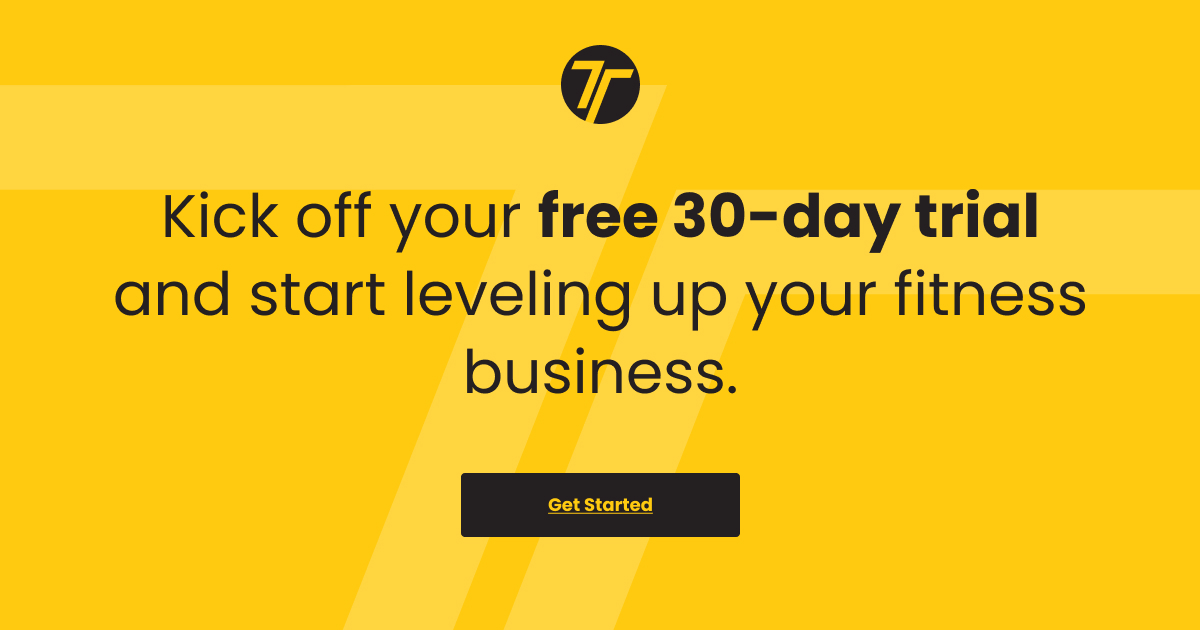
Online personal training is packed with potential. Not only does it give you access to a greater pool of potential clients, but it allows you to take on more work without crowding your schedule or maxing out on in-person sessions—a win-win for any personal trainer. However, in such a new and saturated space, it can feel like a real challenge to sell online personal training. Not only is it still a relatively unfamiliar concept to clients, but taking your training business online almost means you’re competing in an even bigger arena.
That doesn’t mean it’s not possible. It just means you need to get creative with your selling techniques. Use these ideas to spice up the way you sell online personal training and tweak them as you learn what works and what you have time for.
#1: Create an On-Demand Workout Library
Instead of (or in addition to) selling online training sessions and programs, sell access to a library of on-demand workouts for anyone looking to train, whenever or wherever they want. This gives you an easy stream of income once the planning and filming have been done. With the videos online, all you have to do is market them.
The key here is to make sure you collect your client’s email during the purchasing process (which is easy with ABC Trainerize) and turn them into a subscriber on a mailing list to whom you can market your online programs. In this way, your on-demand workout library is a soft sell; an easier ask, and the first step toward getting a new personal training client, which is the harder sell.
#2: Get Your Foot in the Door
Many clients experience sticker shock when they see the cost of a personal training package; even the people who are most excited take a big gulp when they see the numbers. To mitigate the effects of this, start by scheduling them for their first session—before showing them the cost. “Having clients commit to training times and dates makes it harder for them to balk at the sale,” says Jonathan Goodman, creator of the PTDC.
Goodman explains, “In The Art of Choosing by Sheena Iyengar, she calls this the foot in the door technique. Getting somebody to commit to you on a smaller decision increases the chances they will commit to whatever you propose next.” Use this technique to get buy-in and increase the chances they’ll sign up for online training without feeling like you need to discount your services or soften the pricing.
#3: Go the Hybrid Way
Online personal training can be a confusing concept for those less tech-savvy or new to their fitness journey—and may also make people feel like they’re not getting the full experience. For clients who seem to struggle with an online-only approach, go the hybrid method. Use a mix of online and in-person training to ease their concerns and strengthen the workouts they do alone.
As an added bonus, you can charge less for the online portion of the program since you don’t need to meet in person, which may allow you to reduce the price and attract more potential clients. Not to mention, in-person sessions allow clients to build self-efficacy while giving you a chance to motivate them during the workout together and give them goals for their workouts at home.
This blended approach can strengthen your bond as trainer and client while making online training more approachable and successful.
#4: Turn Clients into Ambassadors
If you’re struggling to get sign-ups for online training, find someone who’s willing to do it for free or for a steep discount and make them your “ambassador” for that program. This means all of your marketing materials will revolve around this person, including photos, testimonials, videos, progress notes, etc. For example, you may have the program listed on your site with a link below that says, “See Amy’s Results!” that would take the potential client to a separate landing page where all of the ambassador information can be found.
This idea allows you to use social proof to your benefit. People want to know that others like them have done it, like it, and would recommend it; when you weave these details into a story, the persuasive effect is even stronger:
“User social proof is particularly effective when it involves storytelling. We tend to imagine ourselves in other people’s shoes when we read or hear a story. This is why stories are so persuasive and often more trustworthy than statistics or general trends. Individual examples stick with us because we can relate to them,” says Alfred Lua, Buffer Blog contributor.
#5: Leverage Apps and Digital Tools
In many cases, people who seek online training need guidance, and the thought of going at it alone can be scary. That’s where digital tools and apps like ABC Trainerize come into play. Not only can you brand a tool like ABC Trainerize with your own logo and style—which makes you look more professional—but the features of the app itself can be a selling point for your online training.
Take ABC Trainerize’s progress tracking, check-in, and workout log features. People love tracking their progress! Using a digital tool to facilitate your online training allows for this and a wide range of other benefits, and as such, can be used as a powerful tool for marketing.
Curious how to position ABC Trainerize as a selling point for clients training with you? Try creating a 3-minute walk-through video of the platform, showing potential clients how they could use it and how it can make their life easier and their training more effective. Better yet, track your own progress with ABC Trainerize so you can share Instagram stories, Facebook posts and more—walk the walk, talk the talk, and people may feel more comfortable going into online personal training with you.
#6: Short-Term Transformation Challenges
14-day, 21-day, or 30-day exercise challenges are one of the most effective ways to capture attention online and convert cold leads into paying clients. These short, goal-specific programs are high in energy, easy to promote, and naturally shareable, making them ideal for building traction on social media.
Because they’re time-bound and results-focused, challenges tend to get significant engagement. People save them, rewatch them, and invite others to join in on the fun. And when run entirely online, they’re simple to deliver and scale. You can upload daily workouts, send email check-ins, or host group chats, all without having to meet in person.
From a business standpoint, challenges are a great entry point. They give potential clients a taste of your coaching style and structure, without requiring a significant commitment upfront. Once the challenge ends, it’s easier to offer a more comprehensive program or ongoing support.
📝 Check Out: Summer Challenges: The Key to Beating the Seasonal Slump this Summer
#7: Bundle Training with Habit Coaching
How does that saying go? “Give a man a workout, and you’ll train him for a day. Teach him how to build habits, and you’ll coach him for life.” It once included a fish, but in the current fitness industry, things have changed.
The days of offering just workouts are done; people can ask ChatGPT to become their personal trainers, or download free basic programming from everywhere, often at rock-bottom prices.
If you want to stand out in the online space, you need the complete experience. People want accountability, structure, mindset support, and access to you, not just a PDF. ChatGPT can only take them so far.
That’s where habit coaching comes in. With tools like the ABC Trainerize habit coaching features, you can guide clients through daily routines that support their bigger fitness goals. Think sleep, water, mobility, steps, and stacking small wins that actually lead to long-term change.
When you bundle habit coaching with your training, you shift from being “just a trainer” to being their go-to coach. It makes your offer feel higher-touch without adding more 1:1 time, and it’s the kind of support people will pay for and stick around for, especially when delivered seamlessly through an app.
📝 Check Out: ABC Trainerize Collections: New, Premium Ways to Elevate Your Coaching
#8: Host Live Workouts or Q&As on Social Media
Live workouts and Q&A sessions are a powerful way to connect with potential clients and show what it’s like to train with you, but that doesn’t mean they’re for everyone, or that you should just go live and hope for the best.
If you’re camera-shy or new to showing up online, start small. You don’t need to perform for a crowd. In fact, some of the best live sessions feel casual and personal. You’re not trying to go viral, you’re trying to show your face, share your knowledge, and make people feel comfortable reaching out.
That said, planning matters. Don’t just hit “Go Live” and wait for viewers. Instead, build interest ahead of time. Ask your current clients what they’d want to see. Collaborate with another coach to run a joint session. Or pick a date, announce it in your stories, and collect questions beforehand to shape your content.
Live sessions aren’t a must-do for every coach, but if you have even a small following or engaged client base, they can be a simple, free way to build trust and turn lurkers into leads.
Just keep it relaxed, have a clear CTA at the end, and treat it like a conversation, not a performance.
#9: Create a Lead Magnet (Freebie Funnel)
A lead magnet, creating one and actually using it in your online business model, is all about value exchange. You’re not just building something for free and putting it out there. You’re offering something of value, and in return, you get a lot back as a business owner.
At its core, a lead magnet says: Do you have a problem? I can help you solve it in a very simple way. That’s it. You’re not overpromising, and you’re not pretending to fix their biggest problem overnight. What matters is that it’s a pain-point-specific issue, and you’re offering a solution that someone can digest and benefit from in just a few hours.
In practice, this can look like developing a free resource such as a 7-day workout plan, a meal guide, or a mobility series.
What you get back is important. First, you validate that part of your offer; now you know the problem exists and that people are actually interested. Then, you turn any passive viewer into a prospect.
You will know who’s paying attention and what they care about. From there, you can move into sales, or you can nurture those leads in different ways, or even pitch other ideas based on what you’ve learned.
#10: Launch a Referral Program With Tiered Rewards
Word of mouth and referrals are among the most powerful tools in your personal training business, but they take on a new shape when they go digital. Instead of hoping clients casually mention you, build a referral system that’s fun, repeatable, and integrated.
Start with a tiered rewards structure that incentivizes consistency and volume:
- 1 referral – Branded Merch (e.g., hoodie)
- 3 referrals – a free month of training
- 5 referrals = a custom program or private session
You do need software to run this, not spreadsheets. It doesn’t have to be fancy, but it has to be functional. This is where ABC Trainerize comes in. These limited beta features with Shareable booking links and client referrals are something to keep your eyes on.
It allows clients to share a unique referral link and receive credit once a new client signs up and pays. You can also turn on shareable booking links and let clients invite others directly via text, email, or social media, right from the app.
📝 Check Out: Your Guide to Selling Merch as a Personal Trainer
Increase Your Sales and Revenue with the ABC Trainerize Business Add-On
ABC Trainerize Business streamlines selling by enabling you to package and deliver coaching services directly within the app!
You can create bundles, one-time products, or subscriptions and sell them seamlessly – no need for external platforms. Once purchased, programs are automatically assigned, and clients are onboarded via automated workflows. This takes the legwork out of managing sales and frees you up to focus on delivering results and scaling your business.
Learn more about ABC Trainerize Business, the all-in-one business management software for trainers.
Conclusion
There are more ways to make it happen today as an online personal trainer than there are reasons not to. In fact, there might be too many ways, which is why it’s so important to choose what aligns with where you are in your business right now: your experience, your qualifications, your preferences, and your personality.
Whether it’s launching a short-term challenge, offering habit coaching, creating a lead magnet, or running a referral program, these strategies can help you grow your client base and deliver more value, without burning out or guessing what to do next.
And in a digital world, your system is your space. If you used to meet potential clients at the gym, over coffee, or at the park, now you meet them online, and where you keep them matters.
And ABC Trainerize can become that space. It’s the all-in-one platform that helps you message clients, store names and emails, segment your leads, see what content resonated, track what worked (and what didn’t), and make better decisions moving forward.
Centralizing everything in one system signals to your prospects that you’re running a real business, not just cobbling things together as you go.


